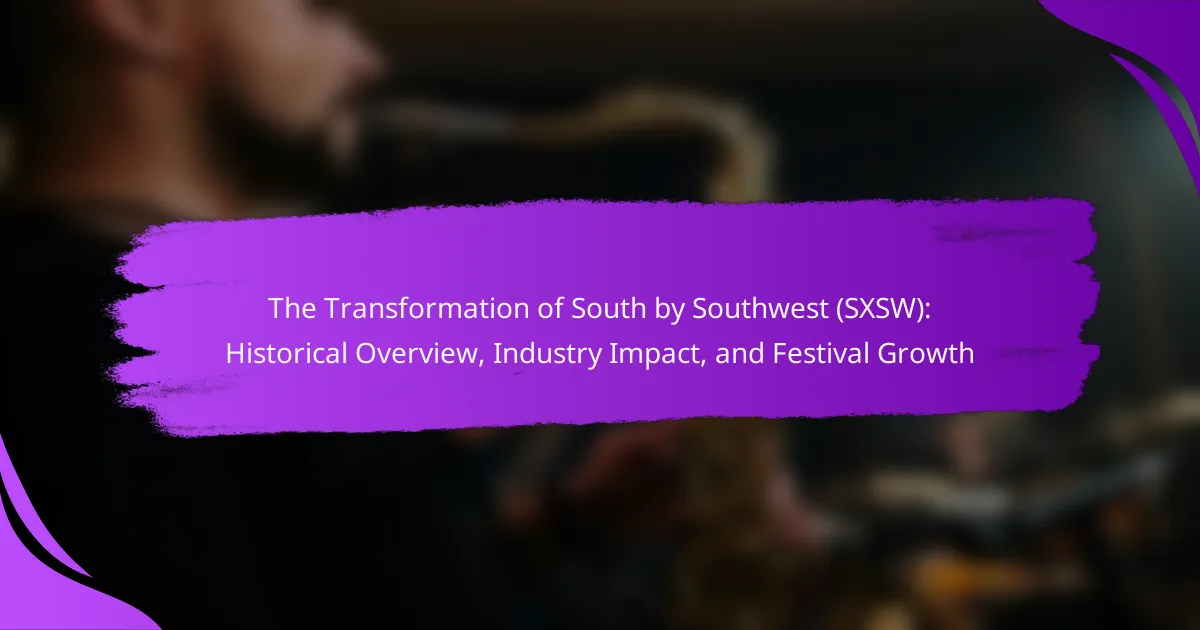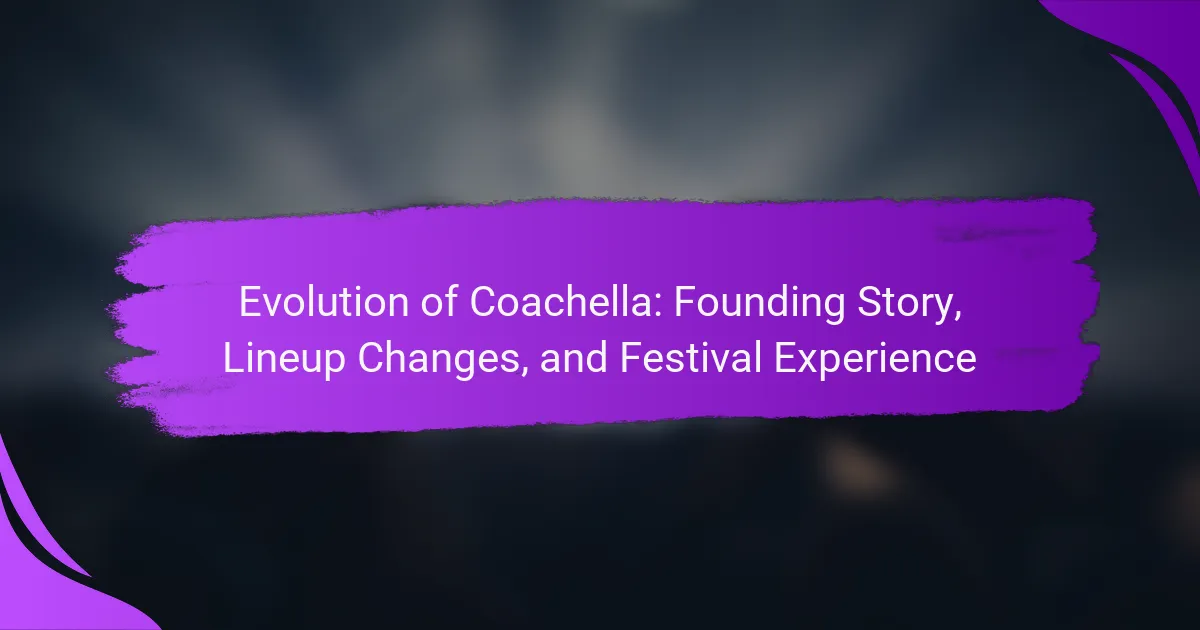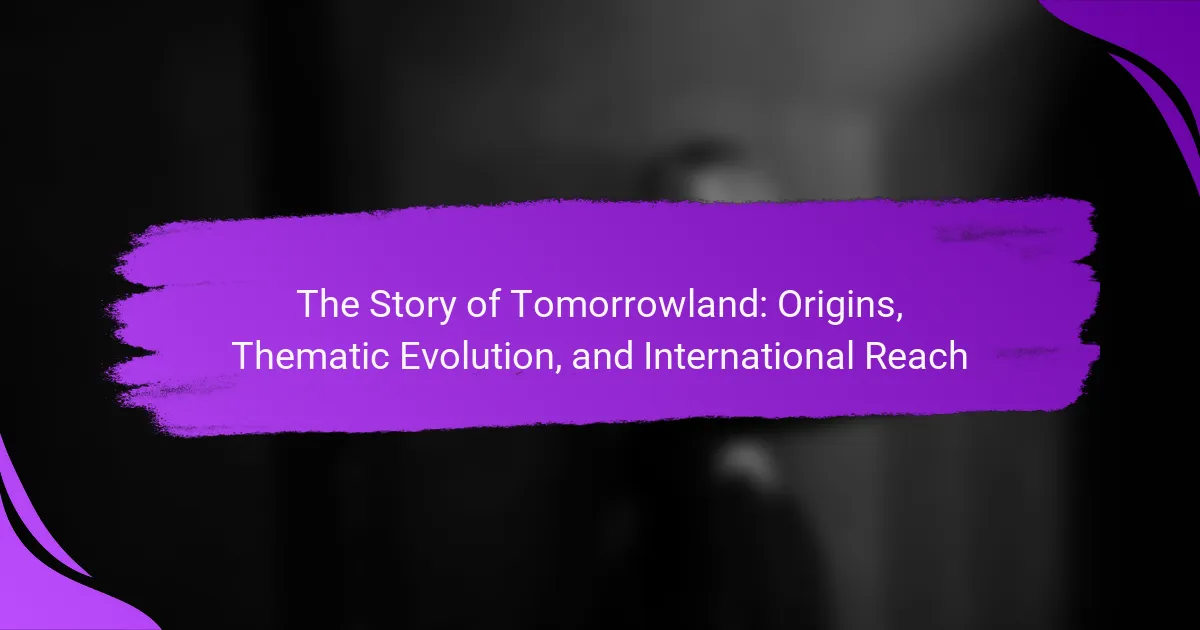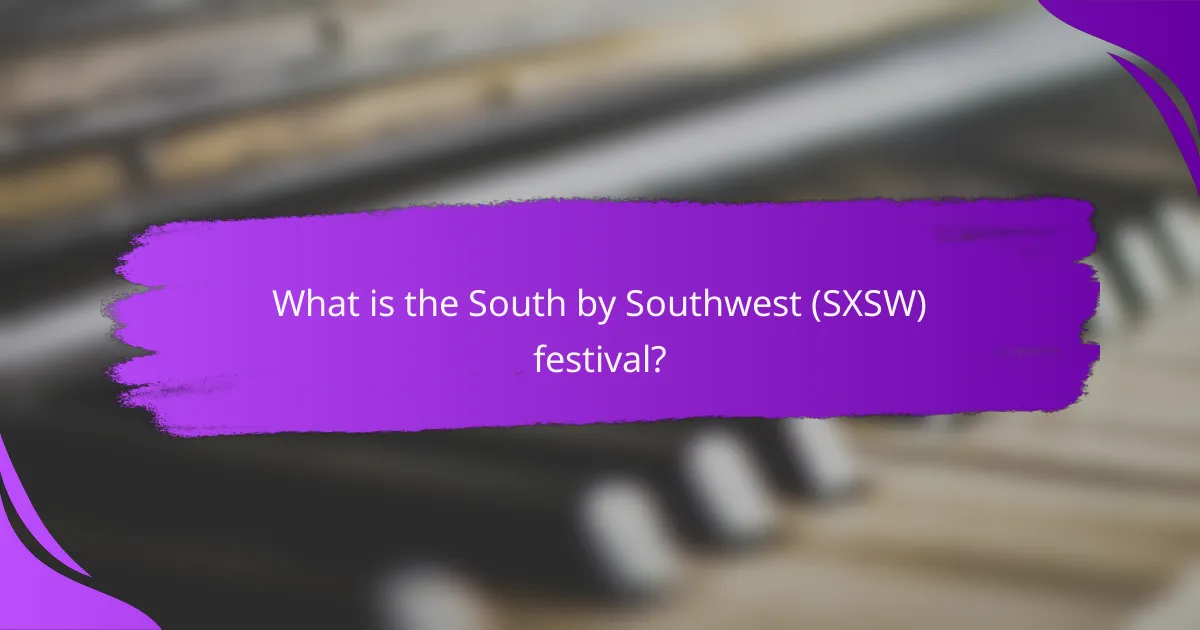
What is the South by Southwest (SXSW) festival?
The South by Southwest (SXSW) festival is an annual event held in Austin, Texas. It celebrates the convergence of music, film, and interactive media. Established in 1987, SXSW has grown significantly in size and scope. The festival includes a variety of activities such as screenings, concerts, and panels. It attracts artists, filmmakers, and industry professionals from around the world. In 2019, SXSW hosted over 400,000 attendees. The event is known for showcasing emerging talent and innovative ideas. It has become a key platform for networking and collaboration in the creative industries.
How did SXSW begin and what were its original goals?
SXSW began in 1987 as a music festival in Austin, Texas. Its original goals included promoting local musicians and providing a platform for networking. The festival aimed to create opportunities for artists to showcase their work. SXSW also sought to foster collaboration among creative professionals. Over time, it expanded to include film and interactive media. This diversification aimed to attract a broader audience and industry participation. The festival’s growth reflects its commitment to innovation and cultural exchange.
What key events marked the early years of SXSW?
SXSW began in 1987 as a music festival in Austin, Texas. It featured over 700 bands performing in various venues. In 1988, the festival expanded to include film screenings. This marked the introduction of the SXSW Film Festival. In 1994, SXSW added an interactive component, focusing on technology and innovation. This expansion attracted a diverse audience, including tech professionals and filmmakers. By 1999, SXSW had grown significantly, with attendance reaching over 10,000. The festival continued to evolve, becoming a major platform for emerging artists. These key events established SXSW as a multifaceted cultural phenomenon.
How has the festival evolved since its inception?
The festival has evolved significantly since its inception in 1987. Initially, it focused primarily on music, featuring local bands in Austin, Texas. Over the years, it expanded to include film and interactive media, reflecting broader cultural trends. By the late 1990s, SXSW became a platform for emerging artists and filmmakers. The introduction of panels and workshops in the 2000s enhanced its educational aspect. Attendance grew from a few hundred to over 400,000 participants by 2019. This growth attracted major brands and sponsors, increasing the festival’s visibility. Today, SXSW is recognized as a leading global event for creativity and innovation. It has transformed into a multi-industry gathering that influences trends in entertainment, technology, and culture.
What are the main components of SXSW?
SXSW consists of three main components: the Film Festival, the Music Festival, and the Interactive Festival. The Film Festival showcases independent films and documentaries. It attracts filmmakers and audiences from around the world. The Music Festival features a diverse range of artists and genres. It serves as a platform for emerging talent. The Interactive Festival focuses on technology and innovation. It includes panels, workshops, and networking opportunities. Collectively, these components create a unique cultural experience. They contribute to SXSW’s reputation as a leading festival in the creative industry.
What types of events are included in the SXSW festival?
The SXSW festival includes a variety of events. These events encompass music performances, film screenings, and interactive media sessions. Music showcases feature emerging and established artists across multiple genres. Film screenings include premieres, documentaries, and short films from diverse filmmakers. Interactive media sessions focus on technology, innovation, and digital creativity. The festival also hosts keynote speeches and panel discussions featuring industry leaders. Additionally, networking events facilitate connections among attendees and professionals. SXSW emphasizes creativity and collaboration across different sectors.
How do the different components contribute to the festival’s overall experience?
The different components of the festival enhance the overall experience by providing diverse activities and engagement. Music performances create an energetic atmosphere, attracting large audiences. Panel discussions offer insights from industry leaders, fostering knowledge exchange. Film screenings showcase innovative storytelling, appealing to cinema enthusiasts. Networking events facilitate connections among attendees, promoting collaboration. Interactive installations engage participants, encouraging hands-on experiences. Food vendors contribute to the festival’s ambiance, providing local flavors. Together, these elements create a multifaceted environment that captivates attendees and enriches their experience at SXSW.
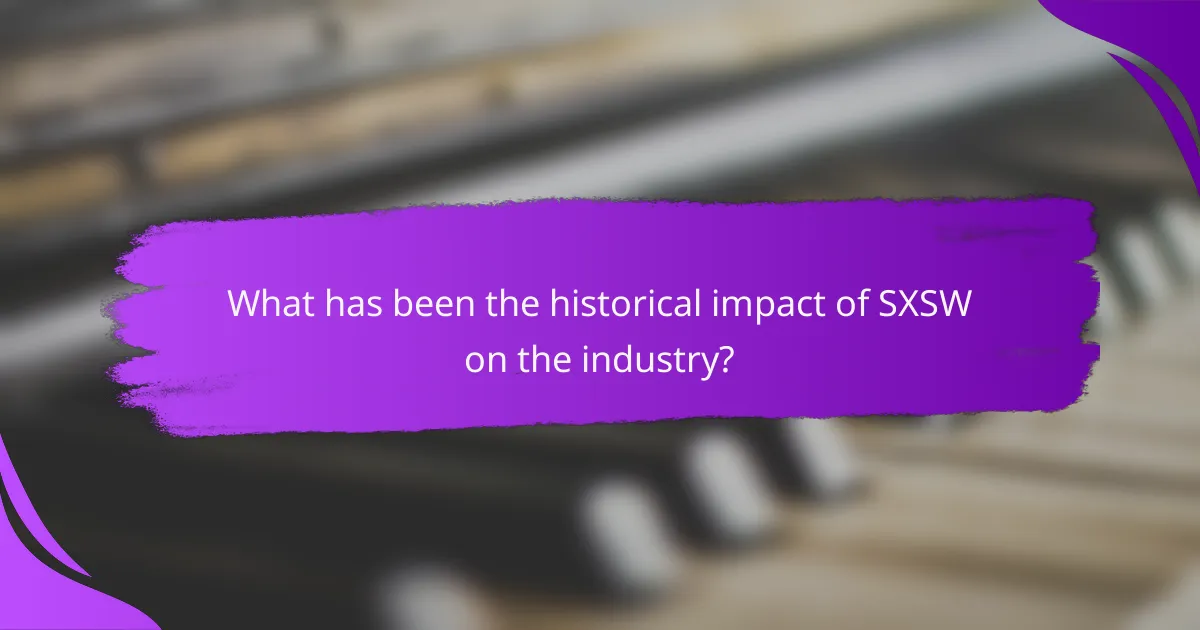
What has been the historical impact of SXSW on the industry?
SXSW has significantly influenced the music, film, and interactive industries since its inception in 1987. It served as a launching pad for emerging artists and filmmakers. Notable acts like Nirvana and the Coen Brothers gained early exposure at SXSW. The festival has also fostered networking opportunities that have led to collaborations and career advancements. In 2007, the introduction of the interactive segment expanded its reach into technology and innovation. This diversification has attracted major brands and investors, reshaping industry dynamics. The economic impact of SXSW is substantial, generating millions in revenue for Austin annually. The festival’s model has inspired similar events worldwide, further solidifying its historical significance.
How has SXSW influenced the music industry?
SXSW has significantly influenced the music industry by serving as a major platform for emerging artists. The festival provides exposure to thousands of attendees, including industry professionals. Many artists have launched their careers after performing at SXSW. The event has also fostered networking opportunities between artists, labels, and promoters. For example, in 2019, over 2,000 musical acts performed at the festival. This contributed to the discovery of new talent and trends in the industry. Additionally, SXSW has shaped music marketing strategies through innovative showcases and panels. The festival’s impact is evident in the increased visibility and success of artists who participate.
What notable artists have emerged from SXSW?
Notable artists who have emerged from SXSW include Billie Eilish, The Strokes, and Chance the Rapper. Billie Eilish gained widespread recognition after her performance at SXSW in 2016. The Strokes showcased their debut album at the festival in 2001, which helped launch their career. Chance the Rapper’s performance at SXSW in 2013 contributed significantly to his rise in the music industry. Other artists like Lizzo and Hozier also gained traction through their performances at SXSW. The festival has a history of propelling artists into mainstream success.
How has SXSW changed the way music festivals operate?
SXSW has revolutionized music festivals by integrating technology and diverse programming. It introduced a platform for emerging artists to gain exposure alongside established acts. The festival emphasizes networking opportunities for artists, industry professionals, and fans. Additionally, it has expanded beyond music to include film and interactive media, attracting a broader audience. SXSW’s model encourages collaboration between different creative sectors. This approach has inspired other festivals to diversify their offerings and enhance attendee experiences. The festival’s emphasis on innovation has set a benchmark for audience engagement in the industry.
What role does SXSW play in the film and interactive industries?
SXSW serves as a pivotal platform for the film and interactive industries. It showcases new films and innovative technologies. The festival attracts industry professionals, creators, and audiences globally. SXSW provides networking opportunities that facilitate collaboration. It features premiere screenings, panels, and workshops. These events foster discussions on trends and challenges. The festival has launched numerous successful projects and careers. For instance, films like “Get Out” premiered at SXSW, gaining critical acclaim and commercial success.
How does SXSW support independent filmmakers?
SXSW supports independent filmmakers through a variety of initiatives. The festival provides a platform for showcasing their work to a global audience. It offers networking opportunities with industry professionals and potential investors. SXSW also hosts panels and workshops specifically tailored for filmmakers. These sessions cover topics like funding, distribution, and marketing strategies. Additionally, SXSW awards prizes to outstanding films in various categories. This recognition can significantly boost a filmmaker’s career. The festival has a long history of promoting innovative storytelling and diverse voices in cinema.
What innovations have been showcased at SXSW in the tech sector?
SXSW has showcased numerous innovations in the tech sector, including advancements in artificial intelligence, virtual reality, and blockchain technology. For instance, AI-driven tools for content creation and analysis have gained significant attention. Virtual reality experiences have transformed storytelling and entertainment. Additionally, blockchain applications have demonstrated new possibilities for secure transactions and digital identity verification. These innovations highlight the festival’s role in promoting cutting-edge technology. The tech sector’s presence at SXSW has expanded, reflecting industry trends and emerging technologies.
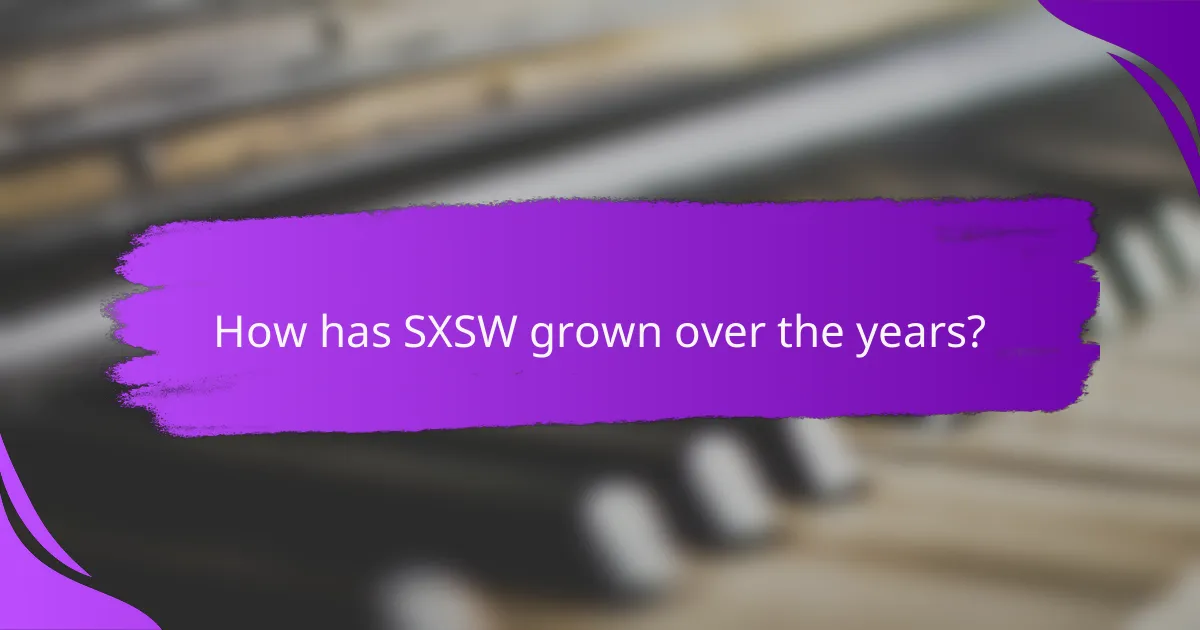
How has SXSW grown over the years?
SXSW has significantly expanded since its inception in 1987. Initially, it started as a small music festival in Austin, Texas. Over the years, it has incorporated film and interactive media components. By the early 2000s, it attracted international attention and participants. In 2019, SXSW hosted over 400,000 attendees from around the globe. The festival now includes numerous panels, workshops, and showcases across various industries. Its growth reflects the increasing importance of creative industries in culture and economy. Additionally, SXSW has become a key platform for emerging artists and technologies.
What factors have contributed to SXSW’s growth?
SXSW’s growth has been driven by its diverse programming and strategic partnerships. The festival features music, film, and interactive media, attracting a wide audience. Increased attendance has been supported by influential sponsors and media coverage. SXSW’s location in Austin, Texas, enhances its appeal with a vibrant cultural scene. Networking opportunities for creators and professionals foster collaboration and innovation. The festival has adapted to industry trends, maintaining relevance over the years. Additionally, its global reach has expanded through digital platforms and international participation. These factors collectively contribute to SXSW’s ongoing success and expansion.
How has attendance changed since the festival’s inception?
Attendance at the South by Southwest (SXSW) festival has significantly increased since its inception in 1987. Initially, the festival attracted approximately 700 attendees in its first year. By 1994, attendance had grown to around 3,000 participants. In 2001, the festival saw a surge, reaching 10,000 attendees. As of 2019, SXSW reported attendance figures exceeding 400,000. This consistent growth reflects the festival’s expanding influence and popularity within the industry. The increase in attendance is attributed to the festival’s diverse programming and its ability to attract major brands and speakers.
What impact has digital media had on SXSW’s expansion?
Digital media has significantly contributed to SXSW’s expansion. It has enhanced global reach and accessibility for attendees. Social media platforms have facilitated real-time engagement and promotion. This has attracted a diverse audience from various industries. Digital media also allows for live streaming of events, broadening participation. The use of online marketing strategies has increased ticket sales. Additionally, partnerships with tech companies have fostered innovation within the festival. Overall, digital media has transformed SXSW into a more inclusive and expansive event.
What challenges has SXSW faced during its growth?
SXSW has faced several challenges during its growth. One significant challenge is competition from other festivals. As the event gained popularity, numerous similar festivals emerged, vying for attendees and talent. Another challenge is managing the increasing scale of the event. Growth has led to logistical issues, including venue capacity and crowd control. Additionally, SXSW has dealt with financial pressures. Rising costs for artists and venues have made budgeting increasingly complex.
The COVID-19 pandemic posed a major setback in 2020, forcing SXSW to cancel its in-person events. This resulted in significant financial losses and a shift to virtual programming. Furthermore, the festival has faced criticism regarding inclusivity and diversity. Ensuring a diverse lineup and audience has been an ongoing concern.
Lastly, adapting to changing industry trends has been challenging. The rapid evolution of technology and media consumption requires constant innovation. Each of these challenges has shaped SXSW’s evolution and response strategies over the years.
How did the COVID-19 pandemic affect SXSW?
The COVID-19 pandemic led to the cancellation of SXSW in 2020. This marked the first time in 34 years that the festival was not held. The cancellation resulted in significant financial losses for the event and local businesses. SXSW typically generates millions in revenue for Austin, Texas. The pandemic prompted SXSW to pivot to a virtual format in 2021. This shift allowed for global participation but reduced the local economic impact. The festival faced challenges in maintaining its traditional atmosphere and community engagement. Overall, the pandemic forced SXSW to adapt to new realities in event management and audience interaction.
What steps has SXSW taken to adapt to changing industry trends?
SXSW has implemented several steps to adapt to changing industry trends. The festival expanded its programming to include more diverse topics such as technology, film, and music. It also introduced virtual experiences to engage a broader audience, especially during the pandemic. SXSW enhanced its focus on sustainability by promoting eco-friendly practices. The festival has partnered with various organizations to foster innovation and inclusivity. Additionally, SXSW has integrated digital platforms for content sharing and networking. These adaptations reflect the festival’s commitment to staying relevant in a rapidly evolving landscape.
What can attendees expect from SXSW in the future?
Attendees can expect SXSW to continue evolving with a focus on technology, music, and film. The festival will likely introduce more immersive experiences and interactive sessions. Innovations in virtual reality and artificial intelligence may play a significant role. Additionally, SXSW is expected to expand its global reach, attracting diverse international participants. Networking opportunities will remain a key feature, fostering collaboration among industry professionals. Sustainability initiatives may also be emphasized in future events. Historical growth patterns suggest increasing attendance and participation from emerging artists and startups. Overall, SXSW will adapt to trends while maintaining its core mission of creativity and innovation.
What trends are emerging for upcoming SXSW festivals?
Emerging trends for upcoming SXSW festivals include a focus on sustainability and inclusivity. Many organizers are prioritizing eco-friendly practices, such as waste reduction and carbon offsetting. The festival is also expanding its commitment to diversity in programming and speaker representation. Technology integration is another key trend, with increased use of virtual and augmented reality experiences. Additionally, there is a rising emphasis on mental health and wellness initiatives for attendees. These trends reflect broader societal shifts and the festival’s adaptability to current cultural demands.
How can participants maximize their experience at SXSW?
Participants can maximize their experience at SXSW by planning their schedule in advance. SXSW features a vast array of events, including panels, workshops, and performances. Attendees should prioritize sessions that align with their interests and professional goals. Utilizing the SXSW app can help in navigating the schedule effectively. Networking opportunities abound, so participants should engage with speakers and fellow attendees. Exploring the festival’s interactive exhibits offers additional insights and experiences. Staying flexible allows participants to discover unexpected events. Lastly, taking breaks helps maintain energy throughout the busy days. These strategies enhance overall enjoyment and engagement at the festival.
The primary entity of this article is the South by Southwest (SXSW) festival, an influential annual event in Austin, Texas, celebrating music, film, and interactive media. The article provides a comprehensive historical overview of SXSW, detailing its evolution since its inception in 1987, including key milestones and expansions into various creative industries. It discusses the festival’s significant impact on the music and film sectors, highlights notable emerging artists, and examines the challenges and adaptations SXSW has faced, particularly during the COVID-19 pandemic. Additionally, the article outlines future trends and strategies for attendees to maximize their experience at the festival.
